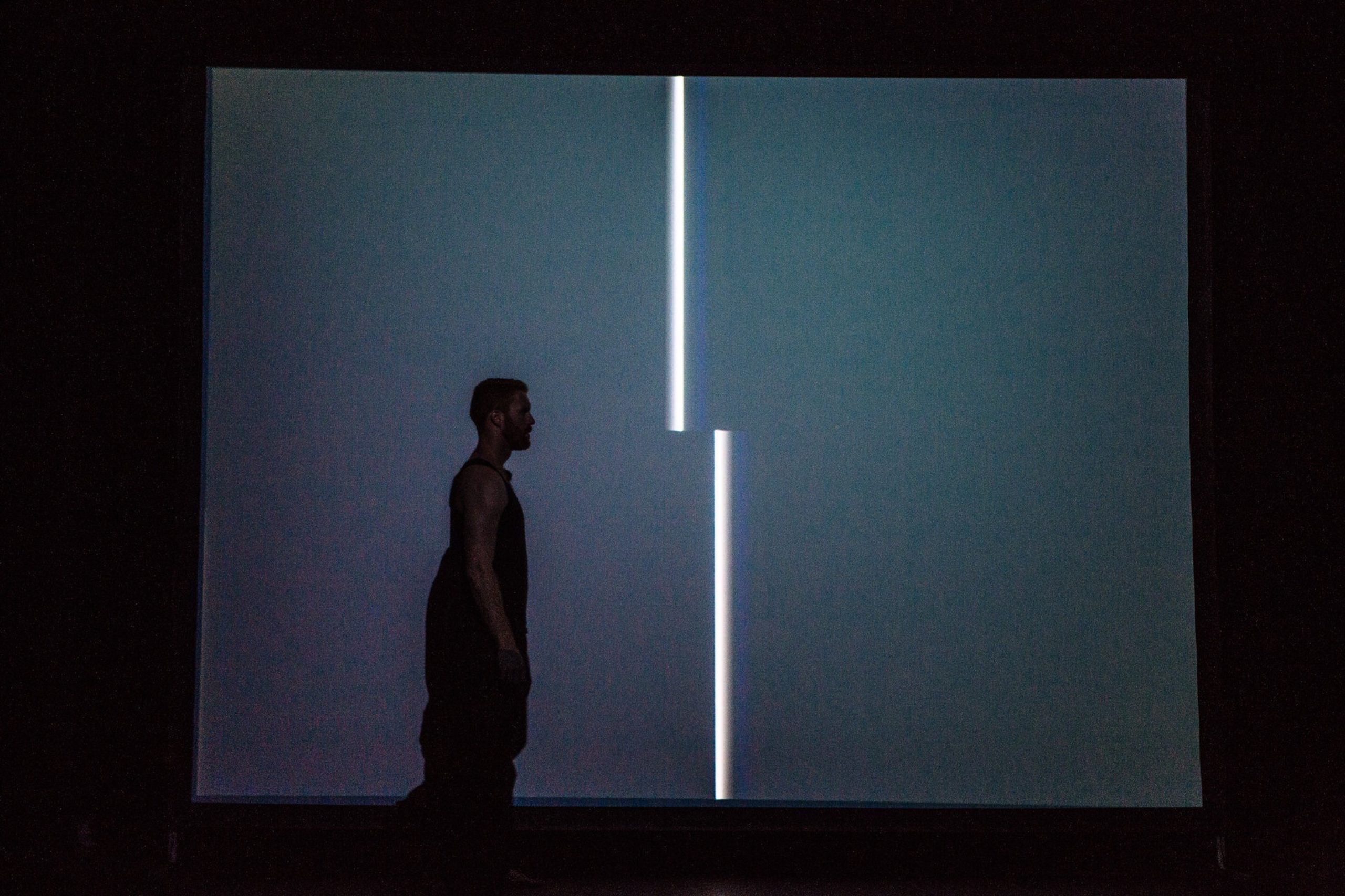
LASALLE College of the Arts, Singapore
Universidad de las Américas Puebla
LASALLE College of the Arts, Singapore
LASALLE College of the Arts, Singapore
The audience sits in darkness with only a thin white horizontal line visible on a projection screen. Multi-coloured LED lights from synthesisers upstage give a sense of the dimension of the space. A short groan of electronic noise heralds the beginning of the performance, subsiding into an inharmonic low-frequency rumble. Subwoofers placed beneath the raked seating induce a corporeal reading of the sound as the intensity grows. One of the visual effects artists decides it is time for the projected thin horizontal white line to disappear. It gives way to more horizontal lines slowly moving from the edges of the screen to the centre, only to disappear once they touch. Repetition ensues.
The two synthesiser musicians consider the effects of this in relation to two specifics — space and time — and make their response. Their improvisation may work in close harmony to audibly mirror the spatio-temporal aspects of the visuals, or instead, the musicians may opt to work in opposition, cutting across them with a dissonant response that contrasts or counterpoints. The visual effects artists, in turn, respond to the new sonic stimuli and the virtuous improvisatory circle continues. Inputs are met with outputs which evolve dynamically in a proto-cybernetic system of circular causality and feedback loops, with the performers conducting abstracted audio-visual dialogues on the dual, and interrelated themes of space and time.
More of the stage becomes revealed by illuminated LED strip-lights attached to large geometric structures. The architectural structures flank the projection screen centre stage creating three areas of focus. The strip-lighting on the structures slowly pulse on and off echoing the slowly undulating electronic rhythm. The first actor appears downstage left, creeping slowly backwards diagonally to centre stage. The lights from the structures and screen fade, only to re-illuminate to reveal a second performer downstage moving in slow motion across the surface of the projection screen. From downstage left a pair move rapidly in a diagonal direction across the stage with their right hands twitching in fast pulsing movements. Slow, monolithic movements are contrasted by fast neurotic repetitions as the initial group of performers gravitate towards the three focal points in the space. All the performers — actors, musicians, and visual effects artists — have trained in “The Viewpoints” technique, and improvise and respond to one another with a heightened awareness of the four “The Viewpoints” of Time and five “The Viewpoints” of Space:
Time: (1) Tempo: how fast or slow, (2) Duration: how long or short, (3) Kinesthetic Response: the reaction to external stimuli, and (4) Repetition: the repeating or recycling of an idea.
Space: (1) Spatial Relationship: how close or how far to something one is and the story that tells; (2) Topography: one’s three-dimensional placement in a volume and two-dimensional placement on a floor; (3) Shape: the positive and negative around us as told by the lines, curves and combinations of those articulated in the body; (4) Gesture: expressive representations of ideas, emotions or concepts and behavioural representations of place, health, time and situation; and (5) Architecture: the influence of the existing space, shapes, colours, light and textures around a performer.

The multimedia theatre performance Viewpoints (2014)[2] was created as part of the Liquid Architecture festival and conference at LASALLE College of the Arts, Singapore, and a thirty-seven-minute video of the event accompanies this paper. The public performance entitled Viewpoints is italicised throughout to differentiate it from “The Viewpoints” methodology. The project, directed by Adam Marple, explored the application and effectiveness of Anne Bogart and Tina Landau’s theatre-focused Nine Viewpoints technique when applied to the creation of an improvised cross-disciplinary multimedia performance for a public audience.
“The Viewpoints” is a tempo-spatial technique of spontaneous and intuitive improvisation first developed by dancer and choreographer Mary Overlie in the 1970s. It breaks down performance into categories relating to space and time and focuses on connecting the body to its environment in real-time. Bogart and Landau adapted and expanded Overlie’s six categories of investigation of how performers may relate their body to the environment (Space, Shape, Time, Emotion, Movement, and Story), into their Nine Viewpoints, detailed above.
In theatre and dance, as well as providing a training method to enhance individual performer’s awareness and creativity, the technique is used as a warm-up method, as a route to building ensemble cohesion, and as a generator of performance content. “The Viewpoints” developed from open laboratories at The Judson Church Dance Theatre in the 1960s, which involved postmodern dance pioneers including Overlie, Yvonne Rainer, Tricia Brown, Lucinda Childs, Deborah Hay, and Steve Paxton. The open laboratories led to the development of a democratic, non-hierarchical approach to creating multidisciplinary artworks in real-time (Bogart and Landau 4).
While most commonly practised by dancers/actors/performers, a primary research objective behind the Viewpoints performance project was to apply the methodology and test its efficacy beyond the actors to the other “performers”: the musicians and visual effects artists. The nine actors were all alumni from the BA (Hons) Acting programme at LASALLE College of the Arts, where they had been trained in the method, but the musicians and visual effects artists had no previous experience. The project involved the latter undertaking a series of “Open Sessions” (jam sessions) to familiarise themselves with the method and to experiment with translating the technique to their own artforms.
Applying “The Viewpoints” to different disciplines requires translating the concepts and terminology into the “language” of the discipline in order for the practitioner to understand the individual Viewpoints through the prism of that discipline. In many ways, when Bogart and Landau developed their Nine Viewpoints, they were “translating” Overlie’s methodology from a dance to a theatre perspective. While the musicians and visual effects artists were inexperienced with “The Viewpoints”, they were highly experienced professional improvisers, and the process of conceptually and practically transposing the technique to their medium ultimately proved less complicated or problematic than anticipated.
Open Sessions were important in building familiarity and for experimenting with the method. Some sessions were undertaken with only the actors and musicians and some with the three “groups” (actors, musicians, visual effects artists) together. During these, everyone interrogated the Nine Viewpoints in relation to their environment as an ensemble, and through the method’s primary “emphasis on instinctual behaviour and physical expression” (Herrington 157). The levels and forms of physicality differed across the three groups. However, whether expansive (the actors dynamically moving or running across the space) or minimal (the visual effects artists using keyboard strokes or typing code), the body, its physical responses and its physical extensions (through the activation of the technologies) remained the bridging element that connected everyone within the multimedia environment.
While the Nine Viewpoints technique is applied in many performer training institutions and in rehearsal rooms to help build content through improvisation that is then later honed and refined towards a performance, in its spontaneously improvised form it is rarely used as a performance per se. The Viewpoints project was therefore unusual in presenting its final Open Session to the public as a performance featuring actors, electronic musicians and visual artists, all applying the same techniques in relation to their particular discipline, as well as to their sensibility and “lens”. Viewpoints was one of the first public performances presented with full production values to use “The Viewpoints” in a multidisciplinary manner towards a collective, non-hierarchical improvisation.
In The Viewpoints Book, Bogart and Landau refer to productions consisting entirely of an Open Session as improvisation (134). Although they acknowledge the centrality of improvisation to “The Viewpoints” as a “common language” between participants, they define using “The Viewpoints” toward performance as Composition (4). Composition uses “The Viewpoints” to create repeatable source material towards a group devised performance and parallels the use of the term in music as a method of creating predetermined pieces. The Viewpoints rehearsal period used Open Sessions not to generate material towards performance but rather to build ensemble cohesion and individual improvisation skills. Viewpoints did not fit neatly into the categories of “improvisation” or “composition” as defined by Bogart and Landau and was an ambitious public Open Session that straddled the divide between a work-in-progress and a production.
Applying “The Viewpoints” to a multimedia environment required the actors to develop an expanded palette of action and reaction. Additionally, it demanded more focus and restraint in response to the various elements in the performance space. Bogart and Landau consider music, and by extension visuals, a “vastly powerful and seductive element in the theatre” and propose that these elements are best introduced after internalising the individual Viewpoints, noting that these new elements are “like bringing another actor on stage” (94).
Introducing music and visuals during Open Sessions saw the ensemble focus too much on these new elements. The first Open Sessions to include improvised electronic music was disorientating for some of the actors who had trouble focusing on their Viewpoints training. There was a tendency towards literal translation of musical elements to movement — for example, slow movements representing slow tempos and small movements representing quiet sounds. Although the relationship between music and movement can be intuitive, there is the potential for actors to fall back into what the director Marple refers to as “call and response mode” when overwhelmed with too many stimuli. He regards “The Viewpoints” and Open Sessions as a litmus test to discover when and how an actor loses focus.
Integration of interactive lights initially generated excitement but, as with the music, there was a tendency to translate visual information into movement too literally. Consequently, new visual elements were introduced one by one with restrictions placed on the rate of change to assist the ensemble to adapt. If a visual mode received too much attention from the actors, it would be turned off or changed. The visual language of the programs oscillated between slowly moving pulsing states to chaotic behaviour becoming stimuli for the musicians and actors.
The rehearsal period for Viewpoints also revealed that collective improvisations resulting from applying “The Viewpoints” required further structuring. Marple began to codify guidelines for the performers that highlighted elements that produced engaging results such as spatial relationships, the use of repetition, and working with the projection screen. The guidelines also included elements to be avoided, such as speaking and having more than seven people in the space at the same time. Speaking or reciting text, for example, posed issues of literal interpretations of stimuli during improvisations. Text, even abstracted, carries embodied meaning and this element worked counter to the goals of the ensemble. The improvisations had no specific narrative and focused on the interaction between all the different elements.
How to end Open Session performances proved to be the most challenging element to master within improvisations. Rehearsals saw time limits applied with either visual or sound-based cues denoting the end of a session. One solution was for the actors to leave the stage with the sound and visuals finishing once they exited. Creating limitations kept the process fresh as it provided boundaries to push against while allowing the freedom of improvisation within those boundaries.
Interdisciplinary forms have a long history of merging music, sets, props, costumes, and lighting to enhance the body in space (Dixon 39). Multimedia is the driving factor that “is continuously pushing the parameters of existing practice and inventing new modes of performance” (Klich and Sheer 11). New technologies challenge established ideas on the nature of theatre and performance, making the addition of interactive visuals and electronic music essential factors in the recontextualisation of “The Viewpoints” from a training methodology towards a performance strategy.
As a performance strategy, “The Viewpoints” enables an ensemble to self-organise and communicate across different disciplines. Members of the ensemble operate as individual agents with decisions informed by the rules of engagement outlined by “The Viewpoints” methodology. This organisational structure is perhaps best understood through the imagery generated by Deleuze and Guattari’s metaphor of the rhizome; a botanical term relating to horizontal stem systems that generate from multiple nodes. The rhizome is a useful way to visualise the complexities of interrelationships and decision-making processes that exist at any given moment in a non-hierarchical performance environment.
The multimedia environment in Viewpoints democratised the performance space, forgoing the traditional roles and hierarchies that accompany conventional theatre and dance. Randall Packer and Ken Jordon consider multimedia as open, democratic, non-hierarchical, fluid, varied and inclusive (xxx). Applying “The Viewpoints” in a performance setting situates the practice ontologically within the “performance” genre, which is a move away from symbolic hierarchies found in narrative-driven theatre.
The ensemble for Viewpoints comprised of nine actors, two musicians playing analogue modular synthesisers and two digital artists controlling live interactive visuals. The performance space contained a large projection screen upstage centre and two large geometric structures flanking the screen centre stage, as seen in Figure 2 below. There was no additional lighting used in the performance. The geometric structures added a topographical element to the space introducing dimension and architecture for the ensemble to consider.
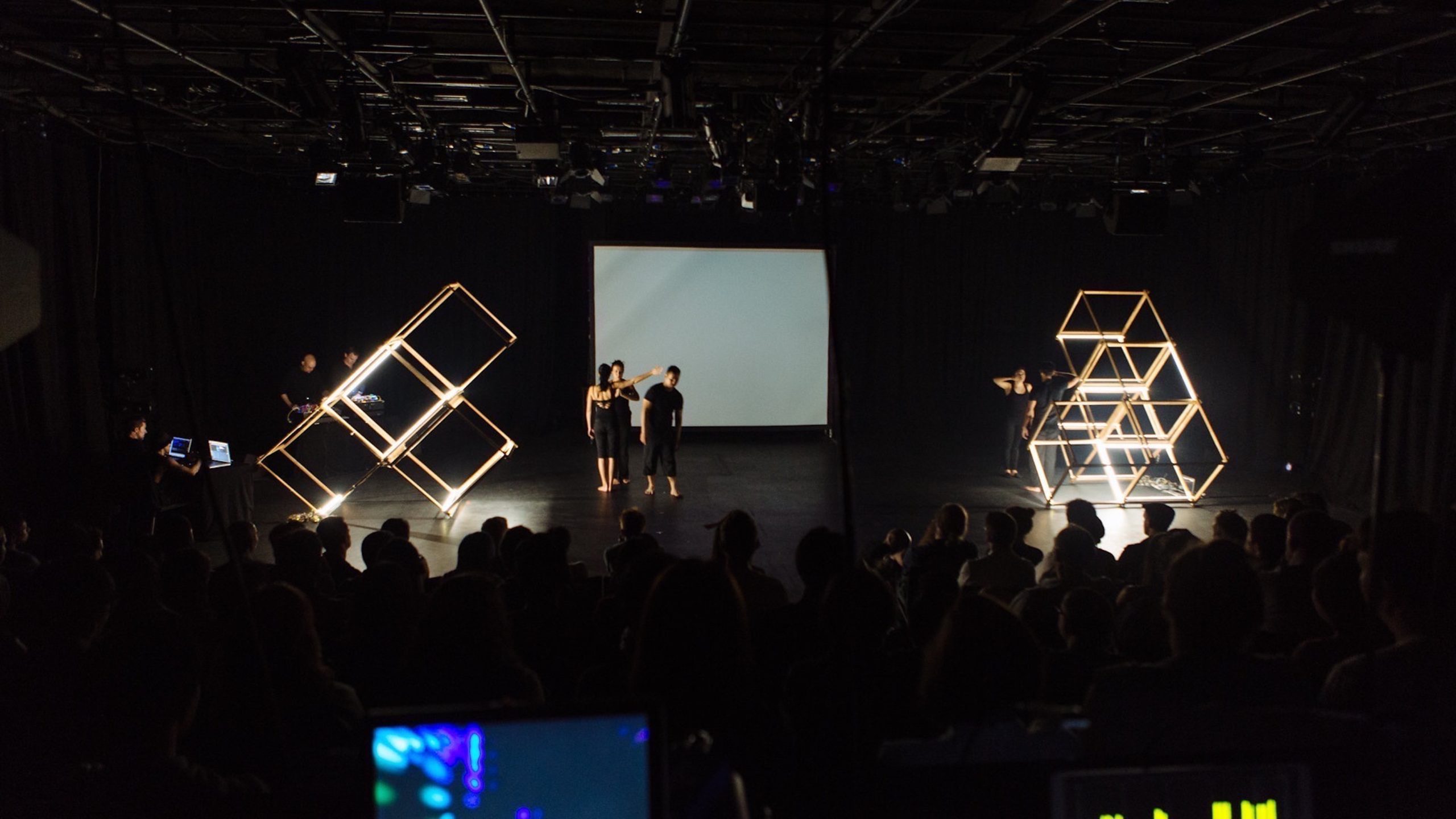
The visual system included two laptops, a projector and sixteen LED strip-lights attached to the geometric structures, constructed from one-meter square wooden frames (see Figure 3). The software and hardware for controlling the interactive strip-lights were custom-built in the open-source frameworks of Processing and Arduino. The software enabled the lights to be illuminated or dimmed individually, or in varied groupings, and to create complex pulsation and ripple effect sequences between them at different speeds, from slow to strobing. The projection screen visuals were geometric abstractions generated in real-time. Although distinct in their appearance and form, both visual elements shared the same input and behavioural parameters that dictated how they reacted to sound.
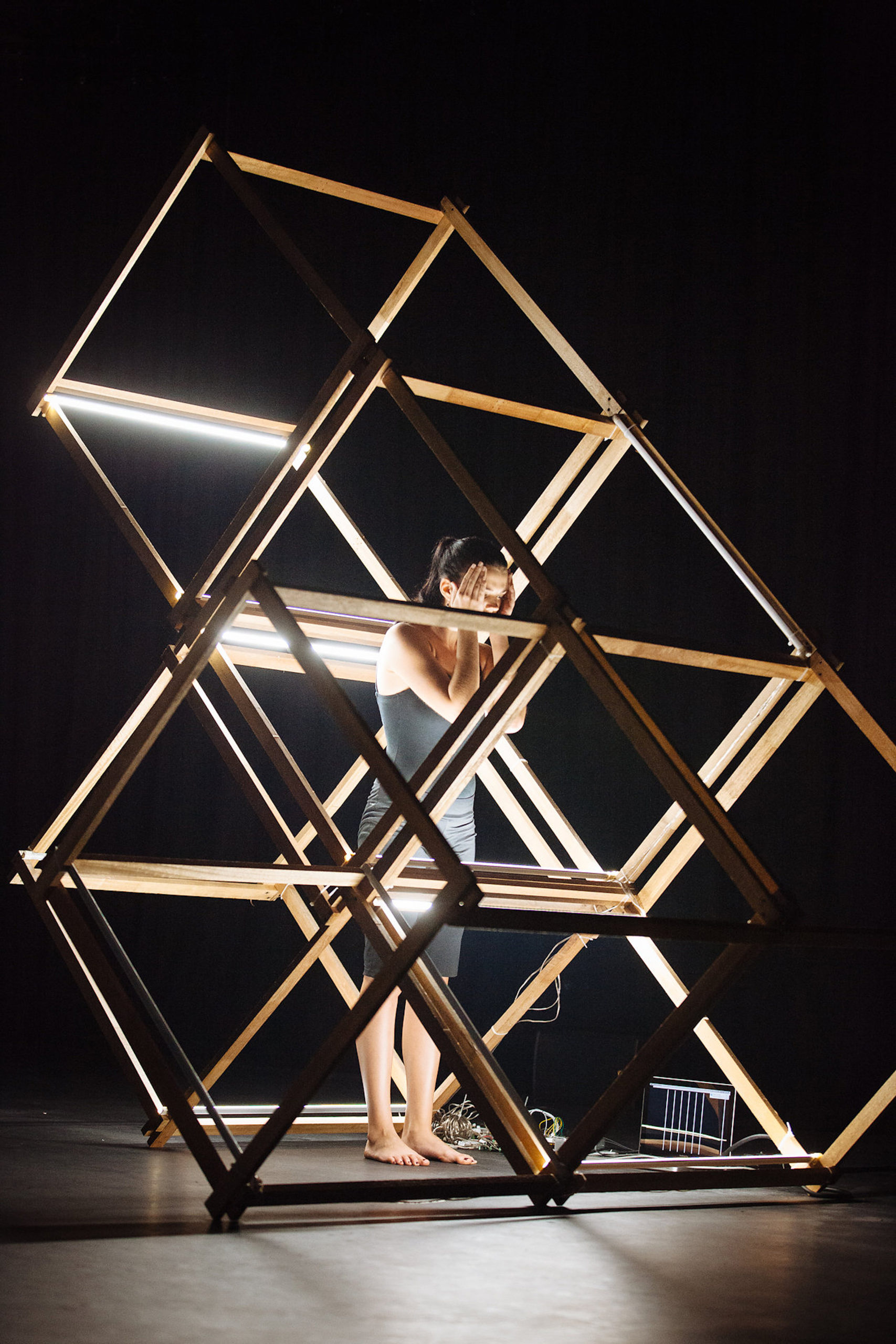
The visual system operators reacted to the visual and sound events within the performance environment using a computer interface controlled by a midi controller and laptop trackpad as a gestural interface, and a computer keyboard as a textual interface. The visuals were programmed to react to sound through the computer’s internal microphones enabling the synthesiser output and sound produced by the actor’s movements to influence the visuals. Additionally, the operators used the gestural and textual computer interfaces to influence the visuals in real-time in reaction to movements of the actors and sounds from the synthesisers. The musicians and actors reacted to the visuals from the projection screen and geometric structures to complete an interactive feedback loop.
The musicians used analogue modular synthesisers with no keyboard, that use patch cables to connect the various components of the synthesiser. The systems comprised of various modules, including conventional components such as voltage-controlled oscillators (VCO), voltage-controlled filters (VCF) and voltage-controlled amplifiers (VCA), as well as hybrid random generating modules. Modular synthesisers use control voltage (CV), first introduced by Bob Moog, as a method of controlling synthesiser parameters using electricity. The musicians prepared performative “patches” that were flexible and controlled the synthesiser in a tactile and expressive way. One of the advantages of modular synthesisers over computers as a performance instrument is the accessibility of the controls and patch cables to allow for real-time manipulation. The “patch” or signal path defines the sonic boundaries of the sound, creating a system that balances control with unexpected results.
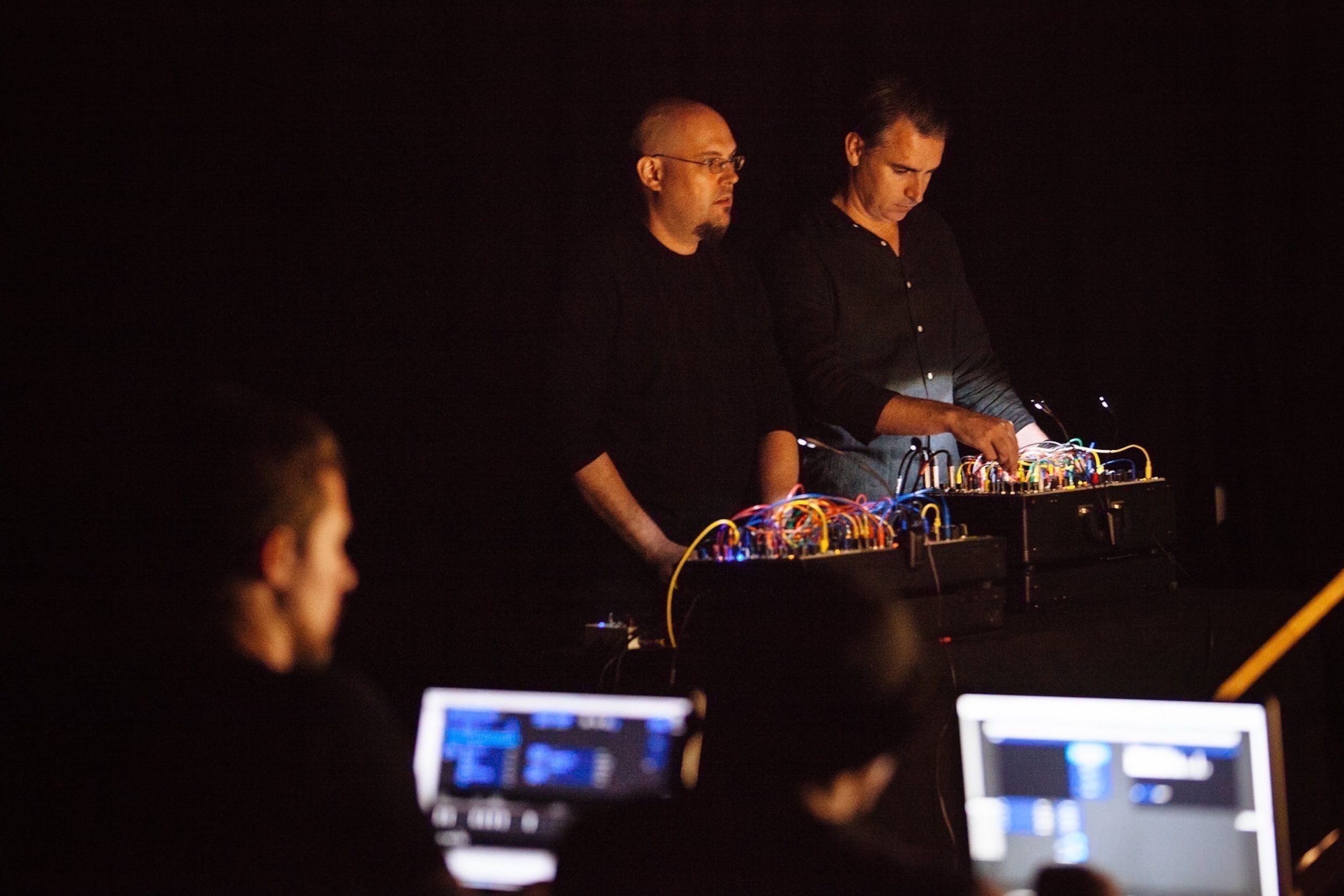
The musical approach for Viewpoints focused on creating background and foreground sonic events. The background events were static and developed at a macro level, slowly unfolding over time. The background provided a sonic context for the performers, creating incidental music that was textural and served as an ambience or mood. The foreground events were gestural and existed on a micro level with the rhythm faster and more immediate. The foreground sounds were the causal events that incited change and occurred in reaction to the movements of the performers or the behavioural patterns of the projected visuals and light arrays.
For the musicians, the actors and lightboxes introduced a three-dimensional spatial element to consider. A multimedia environment increases the number of stimuli and creates complex relationships between the sound and other elements. There was less responsibility to keep the momentum of the music going, offering the choice to play or not. These moment-to-moment decisions of action or inaction were open to all the performers throughout and relate directly to the two quintessential elements of Bogart and Landau’s nine Viewpoints — Space, and Time. For the musicians as well as the others, doing nothing, “leaving space”, and judging its timing and temporal duration (using “The Viewpoint of Duration”) was often found to be as effective as filling it, and could build a real tension that became released as the sounds were re-introduced. The absence of sound hence became a powerful tool which could radically shift the dynamic and focus of the performance. The physicality of the sound was enhanced by placing extra subwoofers underneath the audience rostra. The intention was to intensify the experiential element of sound through exploring the upper and lower limits of volume and frequency, highlighting the physical and psychoacoustic characteristics of sound.
This sense of physicality and viscerality was also reflected across the ensemble and was a notable aspect of how adherence to the Nine Viewpoints method by all participants brought into effect not just a sense of direction or “cohesion” but a distinct and unifying house style and aesthetic. This was also the result of the ensemble’s strategy to refrain from using storytelling approaches entirely, and eschewing text, melody, harmony, metronomic rhythm and representational imagery in favour of non-narrative forms of movement, sound, and visuals. Textures and frequencies supplanted stories, and abstraction and viscerality replaced narrativity. The ensemble aimed to explore the Viewpoints as universal connection points divorced from canonical implications and inherent meaning, and as tools to communicate “purely” without recourse to traditional theatrical, narrative, visual representational or melodic music models. This approach ensured that “The Viewpoints” conceptual focus on time and space remained paramount. The artists were not side-tracked by conventional concerns over issues such as character and plot (the actors), figurative or narrative imagery (the visual effects artists) or “programmatic” music that conjures imagery (e.g. pastoral music) or emotional states (e.g. major key melodies are happy, minor ones are sad).
Central to the Viewpoints performance was an emphasis on multidisciplinary improvisation that was non-hierarchical, with the elements of acting, performance, sound, and interactive visuals afforded equal importance. The two large architectural structures onstage, with their continually changing strip-light effects, also became equal partners within the creative improvisational flow. We argue that non-narrative forms of movement, visuals, and music/sound are best suited to facilitate non-hierarchical interdisciplinary improvisations. This approach allows both audiences and participants to come to a personal or “open reading” of the event and its different elements. The emphasis on space, time and improvisation connects the multiple ontologies that Steve Dixon and Chris Salter argue are inherent to multimedia performances.
Bogart and Landau’s development of Vocal Viewpoints which “addresses sound in the same way that the Physical Viewpoints addresses movement” provides a good starting point for the application of “The Viewpoints” to music and by extension, visuals (105). Vocal Viewpoints provide tools for the actor to interpret their vocals and sounds from their environment. Within the Vocal Viewpoints, the elements of Tempo, Duration, Repetition, Kinesthetic Response, Shape, Gesture, Architecture, Pitch, Dynamic, Acceleration/Deceleration, Timbre and Silence constitute a framework for actors to train with sound (Bogart and Landau 106). This list augments the Physical Viewpoints with fundamental musical elements but excludes The Viewpoints of Spatial Relationship and Topography.
The Viewpoint of Tempo is the rate of speed of a movement, sound or visual event on stage (8-9). The Viewpoint of Duration, relating to form, is how long an individual, group or whole ensemble stays within a section, Kinesthetic Response relates to each ensemble member’s spontaneous reaction to external stimuli be it music, visuals or movements, and Repetition relates to repeating gestures from one’s body or external stimuli. The application of the time elements can be observed in the opening sequence of Viewpoints as described in the Prologue. For example, the low-frequency oscillator drones of the synthesisers, the slowly moving horizontal white lines on the projection screen and the creeping actions of the first actor to enter the stage establishes a Tempo which defines the duration of the first section. Kinesthetic Response is illustrated by the individual decisions of the musicians, visual artists and actors to react with slow-moving, sympathetic sound, visuals and movements. The pair of actors that scurry across the performance space with fast pulsing movements of their hands indicate a decision to contrast the status quo with a different Kinesthetic Response. Repetition occurs on a micro-level to perpetuate ideas and on a macro-level to facilitate form which influences the duration of a section.
The Viewpoints of Space involves further interpretation in order to adapt to musical and visual languages. Shape is the contour or outline the body makes in space (Bogart and Landau 9). Certain Viewpoints were explored or embraced more than others during the project, and Shape was afforded much attention, from the expressive body shapes of the actors to the metamorphosing geometrics of the visual effects artists to the richly contoured frequencies and “noise” effects of the musicians. Shape refers to the lines, curves or a combination of the two that are either stationary or moving through space. Shape also relates to the shape of an individual element and shapes created as a response to other elements. The Viewpoint of Gesture is “shape with a beginning, middle and end” (Bogart and Landau 9), with its equivalent in music being the musical phrase. Visually, it is the behavioural characteristic of a particular visual element. Using the opening sequence of the Viewpoints performance once again, Shape is the horizontal and vertical lines on the projection screen and Gesture are the lines moving from the edge to the middle of the screen. For sound, the low frequency of the sounds represents Shape and the way that two low frequencies interact to create an undulating rumble represents Gesture.
The Viewpoint of Architecture represents the physical environment and how it affects movement (Bogart and Landau 10). This Viewpoint relates to the dialogue that emerges through the individual elements interacting within a performance environment. Although Bogart and Landau do not consider Spatial Relationship and Topography applicable for Vocal Viewpoints, both Viewpoints can relate to sound and visuals. Bogart and Landau define Spatial Relationship as “the distance between things onstage, especially (1) one body to another; (2) one body (or bodies) to a group of bodies; (3) the body to the architecture” (11). This Viewpoint relates to density which can be applied to both music and visuals by how dense or busy they are relative to the other elements. Lastly, the Viewpoint of Topography which is one’s three-dimensional placement in a volume or two-dimensional placement relates to the “footprint” created. Concerning sound, this can be translated as volume and for visuals, brightness.
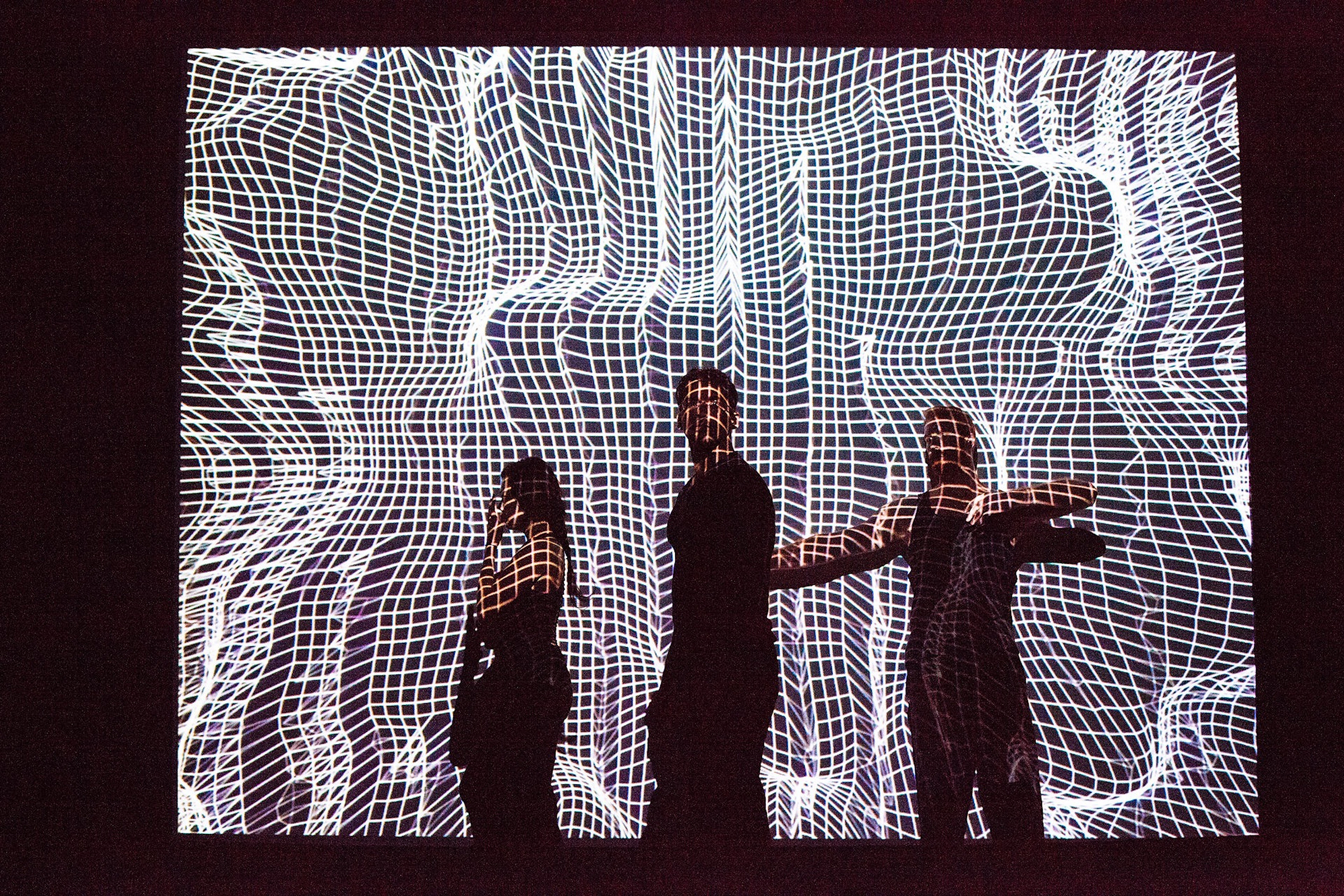
Figure 5 demonstrates one moment at the cusp of a transition where “The Viewpoints” are in action. At this point, the focus within the space is on the projection screen upstage. No other light sources are engaged, creating a movie theatre-like Topography within the space defined by the light from the projection surface. Other actors are in the space yet cannot be seen. The use of light to define the space thus becomes a dynamic element. The music creates a cacophony of machine-like percussive gestures of different pitches and uses internal Repetition to define a small section highlighting The Viewpoint of Duration in action. On-screen projection changes highlight the visual aspects of working with “The Viewpoints” of Gesture and Shape to bend and morph the image that is a direct result of a Kinesthetic Response to a change in the music. The visual state reacts autonomously to the music input, and is in turn further treated and manipulated, manually by the artists in real-time.
The actors engage in The Viewpoint of Architecture to create dynamic contrasts to the musical and visual elements at this moment. The actors in the centre and right-hand side in Figure 5 contrast the busy nature of the music and visuals by remaining stationary and moving slightly, and slowly; ominous yet laden with potential. The actor pictured on the left-hand side contrasts her fellow actors by moving slowly from right to left, with a different shape to her hands and body position. Her movement across the screen surface ushers in a transition into a new section that sets off a chain reaction changing the nature of the music and engages the three-dimensional structure stage left with an eruption of activity, with its ripples reverberating throughout the performance space, igniting a new phase of spatio-temporal improvisations.
Through a practice-as-research process of translating the individual Viewpoints to elements in music and visual languages, “The Viewpoints” methodology became an efficacious interdisciplinary framework to support new improvisatory structures and paradigms for multimedia performance. Through breaking down the elements of performance and offering a methodology to engage in each element individually, “The Viewpoints” provides a rigorous yet open-ended structure to aid collective improvisations. As music and interactive visual effects are time-based art forms, The Viewpoints of Time were adapted easily to them, while The Viewpoints of Space required some reinterpretation or expansion to be effectively utilised. The result of this enquiry found that it was not necessary to change the nature of the individual Viewpoints, but they did require translation and augmentation to be adapted to live sound and visuals effects practices.
The Viewpoints performance is part of a lineage developed by Overlie and adapted by Bogart and Landau that re-contextualises “The Viewpoints” as a performance methodology towards staged, open form, multidisciplinary improvisations. The strength of “The Viewpoints” as a methodology lies in its flexibility, adaptability and intuitiveness, and notable findings of the project included its ready adaptability for use by different art forms and its relative success when employed as a conceptual superstructure to support entirely improvisational and non-narrative public performance. The transformative nature of “The Viewpoints” method produced unforeseen yet arresting results in the Viewpoints performance including a cohesive, unifying aesthetic characterised by physicality and viscerality, and powerful moments where the intersecting forces within the multidisciplinary environment converged coherently, intuitively and synergetically.
[1] Accompanying this paper is a 37-minute video documentation of the Viewpoints performance that is the focus of the inquiry. The video documents a one-off performance at Liquid Architecture, Singapore on 10 October 2014 and provides an example of the application of ‘The Viewpoints’ within a live improvised setting. The performance was a culmination of an intensive rehearsal period exploring ‘The Viewpoints’ methodology across different disciplines and represented a contemporary application to a multidisciplinary performance environment that includes actors, musicians and visual artists.
[2] Viewpoints at Liquid Architecture Singapore 2014 was supported by a Research Project Funding grant from the LASALLE College of the Arts research committee.
Bogart, Anne, and Tina Landau. The Viewpoints Book: A Practical Guide to Viewpoints and Composition. Theatre Communication Group, 2005.
Dixon, Steve. Digital Performance: A History of New Media in Theater, Dance, Performance Art, and Installation. Massachusetts Institute of Technology Press, 2007.
Herrington, Joan. “Directing with the Viewpoints.” Theatre Topics, vol. 10, no. 2, 2000, pp. 155-168. https://doi.org/10.1353/tt.2000.0014
Klich, Rosemary, and Sheer, Edward. Multimedia Performance. Palgrave MacMillan, 2012.
Packer, Randall, and Jordon, Ken. Multimedia: From Wagner to Virtual Reality. Norton, 2001.
Salter, Chris. 2010. Entangled: Technology and the Transformation of Performance. MIT Press, 2010.